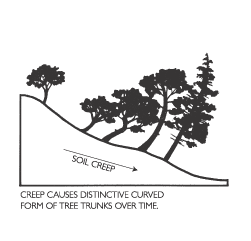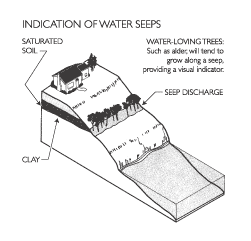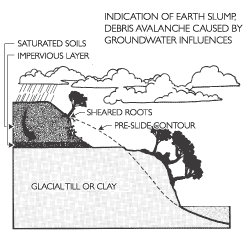Reading the Land: Vegetational Clues Of Slope History And Stability
The species, age, health, and condition of trees and other vegetation observed on a given Puget Sound shoreline can provide valuable clues for determining the present stability of a marine slope. The presence of leaning or jackstrawed trees, as well as the successional stage of the plant community on the site can also indicate when the last slope failure may have occurred and tell you something about previous land management activities such as logging and slope modifications. Vegetative clues should be interpreted in conjunction with hydrogeological observations and historical photographs when available.




Leaning trees may indicate:
- Soil creep (curved trunks).
- Past sudden shallow landslide (straight, dead trees).
- Deep-seated rotational slide (large, live trees, leaning up slope).
Leaning trunks with vertical tops may indicate:
- Past rapid slide within rooting zone.
Jackstrawed trees may indicate:
- Active, large-scale ground movement.
Split trees may indicate:
- Roots half in stable soil and half in unstable soil.
Groups of even-aged trees growing across a slope may indicate:
- Establishment of pioneer species after a slide.
- Areas of groundwater discharge.
- The location of an impervious geologic strata.
Groups of even-aged trees oriented up—and downslope may indicate:
- Slide path.
- Groundwater seep discharge.
- Gully.
Water-loving trees (e.g. alder) and other vegetation (e.g. salmonberry, horsetail) may indicate:
- Seeps, springs, or other hydrologic features.
Immature trees may indicate:
- Recent logging of slope.
- Recent landslide.
Bluff face without vegetation may indicate:
- Recurrent erosion/landslides.
- Soil which will not support vegetation.
- Compact subsoil too steep to retain topsoil.
Old-growth trees or stumps on slopes may indicate:
- Stable site (at least for last 300 years).
Mature conifer trees and associated late-successional understory plant community may indicate:
- A relatively well-drained, stable slope.
- No recent slope failure.
Age of trees growing on benches or terraces of a complex slope may indicate:
- Period of time since last mass failure.
- The site of an inactive old slide.
Buried logs, stumps and vegetation may indicate:
- Past or active earth movement.
- Clearing debris.
Windthrown trees may indicate:
- Shallow rooting caused by:
- Shallow soils.
- High water table.
- Recent exposure to wind caused by:
- Adjacent clearing.
- Severe atypical storm.
- Presence of root rot.
Broken-topped trees may indicate:
- Wind damage to trees previously protected.
- Ice or snow damage.
- Atypical storm damage.
- Incidence of insects or disease.
Trees with older multiple tops or misshapen form may indicate:
- Past storm damage (ice, snow, wind).
- Past view topping.
Dense growth of brush may indicate:
- Hidden slide paths.
- Recent disturbance. (e.g. clearing, logging)
- Groundwater discharge and saturated soils.
Vegetational development at the base(toe) of marine slopes may indicate:
- Presence of an accretional feature.
- Absence of wave attack.
- Past landslide activity
Vertical scarps at the base(toe) of a marine slope may indicate:
- Active wave attack.
- An extremely erosion-resistant geologic strata.
References
- Vegetation Management: A Guide for Puget Sound Bluff Property Owners, E. Menashe, 1993. WA State Department of Ecology. Pub. 93-31.
- Characteristics That May Signal Presence of a Slide, G. Thorsen, in Washington Geologic Newsletter, Vol. 15, No. 3. July, 1987.
- Illustrations from: Vegetation Management: A Guide for Puget Sound Bluff Property Owners, 1993.